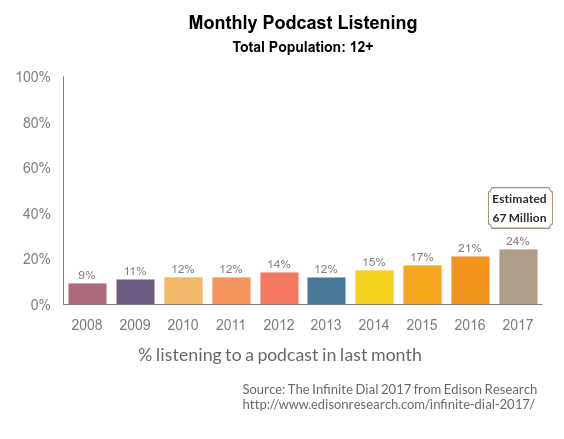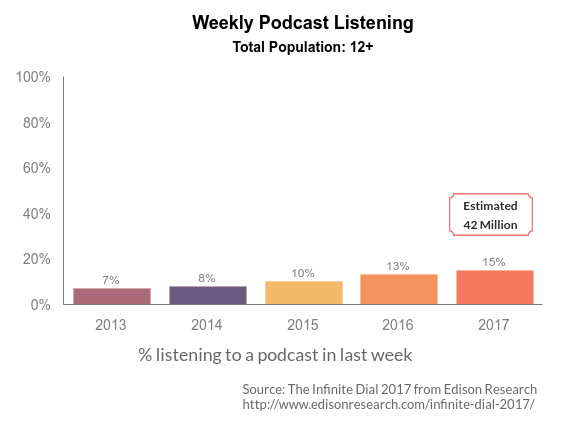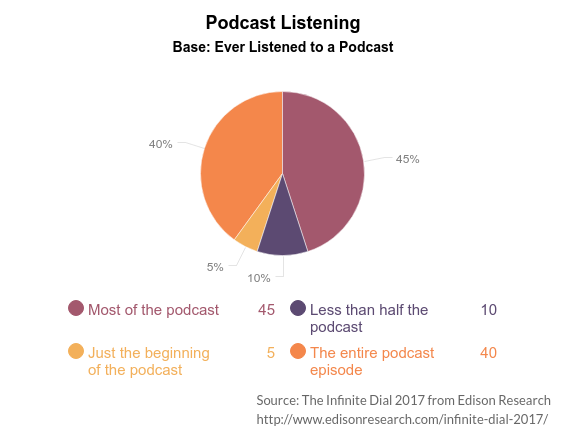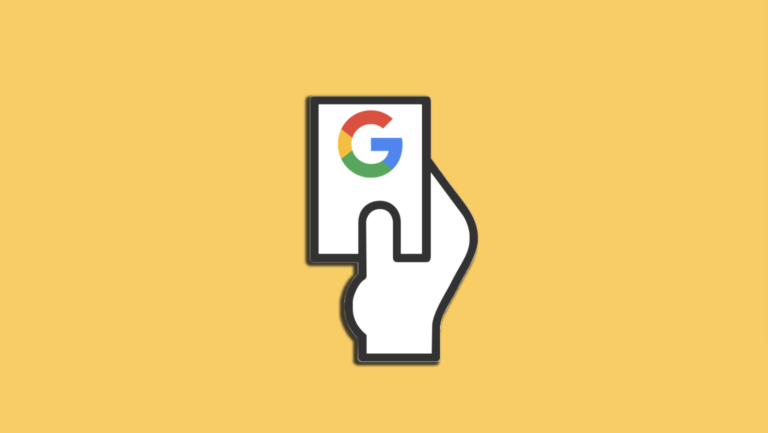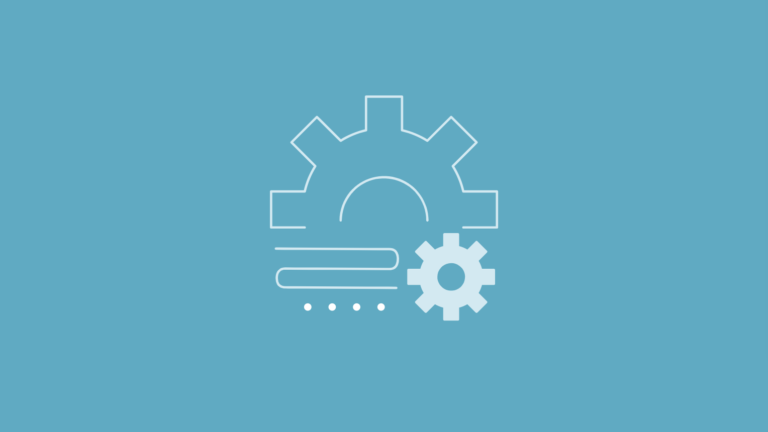8 Reasons Podcast Ads Should Be In Your Marketing Plan
Chances are if you’ve ever heard of SquareSpace, Blue Apron, or Audible, you probably first heard about them on a podcast. These brands sponsor quite a few shows, and in return have gained a decent amount of brand recognition. What makes podcasts so appealing to these brands, and why should more marketers (like you) consider this not-so-niche-anymore segment? This list, created with the help of our resident podcast enthusiast, Maddie Goodwin, will explain why she and other listeners are more likely to buy products they’ve heard advertised on podcasts. It will also show the value for companies to advertise in this growing space.
1. More than 67 million people listen to podcasts every month.
And that’s up nearly 18% from 2016, so it’s safe to say the number of consumers listening to podcasts is on a steady growth trajectory. The number of diehard fans, those who listen to podcasts on a weekly basis, has jumped up to 42 million people from an estimated 35 million in 2016.
And while it may have been their first taste of this medium, these listeners aren’t just frequenting Serial or its spin-offs. Top ranked podcasts are as varied and diverse as they are addictive, with hosts ranging from nerd culture kings to past Bachelor contestants and NPR personalities. There really is a podcast out there for everyone!
2. The “unreachables” are listening, too.
You know the type: cord-cutters who skip YouTube ads and have ad blockers enabled. People who aren’t paying for cable anymore are paying more for ad-free subscription services, like Spotify, just to escape the barrage of unwanted advertisements. And according to Sarah Van Mosel, chief podcast sales and strategy officer of Market Enginuity, 70% of podcast fans use ad blockers online. They’re not seeing or hearing many traditional ads, but with podcasts … (see #3)
3. People actually listen to the ads (and the entire podcast).
Listeners are less likely to skip an ad read on a podcast because they don’t want to miss part of the show. And with the right host + product combo, host-read ads can feel like a natural part of the podcast episode. Additionally, ads are typically read at the beginning, middle, and (sometimes) end of the podcast. With 40% of people listening to entire podcasts and 45% listening to most of the podcasts, that gives you multiple opportunities to leave an impression.
“What makes podcast ads stand out? A few things. The host read/native spots. And the active type of listening that makes the ads more memorable. If I take the time to listen to a podcast I am activating my brain to follow the story or learn something. It’s different than the passive, background listening that is true in music and other types of audio.”
– Maggie Taylor, Public Radio Exchange
4. It’s a platform for word-of-mouth marketing.
There’s nothing quite like a recommendation from a friend. That’s what great podcast ad reads feel like. Listeners invest so much time in podcasts that they tend to feel a connection with their hosts. These relationships mean listeners trust the hosts and value their opinions. So when all ads are: A) read by the hosts, and B) purposely infused with their personality, it feels like “genuine” word-of-mouth, not just someone selling you a product. In fact, the relationship between the hosts and the brands themselves plays a big part in this. When hosts and brands are a perfect match, everything feels natural, and listeners can tell. Chelsea said it best in her post about brand personas:
We want real, relatable content. We want brands that represent qualities that align with ourselves and our beliefs. Brands need to infuse their Social content with relatable qualities to maximize the brand power.
Just replace “Social content” with “podcast ads” and you have the same message. Pick podcasts that are relevant to your audience with hosts that mesh with your product or service for that natural, relatable feel.
5. The target demographic research is precise.
Emotions aside, the data is there. If you want to target college educated women between 25-44 who buy gluten-free products every month that get delivered to the home they own, you can do it.
Podcast listeners take part in regular surveys because they realize it’s a symbiotic relationship. They tell podcast production and media companies information about them so those companies can offer relevant brand ads. They share the kinds of things they buy, their interests, income, and much more.
6. There are easy ways to pay and measure ROI.
Podcast ads are typically purchased through podcast advertising networks, like Midroll and AdvertiseCast, on a CPM (cost per thousand) basis. The “thousand” in this case is measured by guaranteed user downloads, which are based on the number of subscribers a podcast has. According to AdvertiseCast, the industry average rates for a podcast with 5,000+ listeners are:
- $15 for a 10-second Ad (CPM)
- $18 for a 30-second Ad (CPM)
- $25 for a 60-second Ad (CPM)
But how can you tell if the ads are working? The three most popular ways to track success are through unique checkout codes, vanity URLs offered in the ad, or the old “how did you hear about us?” prompt at checkout. While some of these options have flaws, such as coupon codes being spread on sites like RetailMeNot, they offer a few easy ways to gauge how your podcast ads are performing for specific shows.
7. They offer an elevator pitch for your product.
Podcasts are the perfect medium for companies who have a great product but need some help selling the idea of it. If your goals are about driving awareness for your product or service, or you have a proprietary product that requires a little bit of explanation, look no further. Ad spots should be kept short, so they should be succinct and to-the-point while highlighting your product’s best features.
8. Over 80% of listeners can recall the brand.
Midroll Media conducted a recall study of 11,123 podcast listeners and found that:
- 80% could recall at least one brand advertised in an episode
- 67% could recall a specific product feature or promotion
- 51% were more likely to buy from the target brand
They also found that longer campaigns perform better than shorter ones: campaigns with ads on five or more episodes of a podcast lead to 39% more listener recall than campaigns with one ad spot. This means consumers are actually listening to the ads and not tuning out as they might with other mediums, like TV or radio.
I’m Interested…Now What?
Now that podcast advertising has piqued your interest, you need to decide if it’s right for your company. Here’s what you need to consider if you want to convince your boss or client that this is a valuable addition to your marketing strategy and get started immediately:
- Finances: $10k is the recommended amount of ad spend a month for podcasts. Does this line up with realistic customer acquisition costs, lifetime value, and other important metrics?
- Audience: Is your target audience there? The largest age group for podcasts overall is 25-54, but this varies by podcast (as will other demographics). Is there potential for a new audience here?
- Marketing Mix: Will this be a game changer for your business, or just a supporting piece in your mix?
If you determine that advertising on podcasts would be a good fit and your client or boss gives the okay, here are a few tips for adding them into your strategy:
- Start small. One ad on one podcast won’t cut it, but you can try running a few ads on several relevant podcasts to test the waters before going all in. When you start to see results, branch out.
- Test. Test your ad messaging. Test different shows. Test the number of spots you run on each show (but remember that five or more ad spots run on a show leads to better recall). Use these tests to tweak and refine when necessary until you find your stride.
- Test against radio ads. If you or your client are running radio ads, test them against your podcast ads to see how they compare. Depending on the results, you may even begin to slowly replace your radio ads.
“Know that there is some trial and error in the podcast advertising space. Sometimes you find a podcast with what you believe is a perfect audience with a great host and the campaign doesn’t perform as expected…and then sometimes you are surprised the other way!”
– Dave Hanley, AdvertiseCast
Update: Barriers to Entry
After speaking with a few brands, podcast networks, and advertising companies, we uncovered more information about the barriers to entry involved with podcast advertising. For many subscription companies, podcast ads are not a viable option at the moment. It is either something they do not have the budget for, or the reach is too broad. As Kim Keitner at Fresh City Farms explained to us:
“I’ve noticed a prevalence of meal kit companies on podcasts and we’ve discussed it, but the podcast audience is too wide for our purposes. We’re GTA-based (Greater Toronto Area), and while there are definitely many podcast listeners in the GTA, we just don’t feel this avenue of advertising is targeted enough for a smaller, local company like ours.”
Additionally, many brands aren’t convinced that listeners are actually listening. Public Radio Exchange’s Maggie Taylor argues that “No metrics prove viewing/listening. TV ratings don’t take into account when someone leaves the room, skips the commercials, etc. Most metrics other than CPA depend on a bit of a shared myth.”
Some brands also worry about the freedom they have to hand over to podcast hosts in order for them to create natural-feeling ad reads. AdvertiseCast’s VP of Business Development, Dave Hanley, notes that advertisers can request a pre-air check to review the spot before it goes live to help them ease into giving hosts more creative control. He also suggests giving hosts a set of talking points structured around a personal story, the outcomes of your product or service, and a call-to-action to ensure they deliver the important points while still having the flexibility to get creative. Dave also recommends leaning on to experts within the podcast advertising industry to find out what does and doesn’t work:
“These folks will not only provide you with great suggestions for content, but also recommend the shows that they believe will best represent the brand. Being a relatively new space for many marketers, many of us have resigned ourselves to the fact that education is a key part of our role as podcast advertising advocates.”


